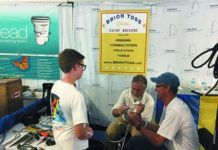Torqued Off
I must take issue with Tim McGauleys statement in Mailport of your August 14, 1997 issue. He states, Torque is a measure of energy… That simply is not so. Torque and energy are two completely different concepts. It is true that in the English system of measurement a common unit for torque is the foot pound which, coincidentally, is the same combination of force and distance units that describe the concept of energy and mechanical work. To avoid this confusion, some writers use the unit of lb. ft. for torque and ft. lb. for energy, though I am not convinced this really helps matters much.
If the U.S. would adopt the SI unit system the confusion would be eliminated, or at least minimized. In this system, energy is measured in joules (J) and torque in newton meters (Nm).
Does all this detract from the intent of his letter? I think not, but I cannot abide the publication of bad physics.
Derwin H. Stevens
Professor of Physics, Emeritus
Stone Ridge, New York
Torque is simply the moment exerted by a force applied at a radius about some turning point. It is measured in lb. ft. and has nothing to do with energy, which is the work done when a force moves through a finite distance. This is measured in ft. lbs. Power, as McGauley correctly states, is the rate of using energy, which is ft. lb./sec.
David Collings, PE
Trumbull, Connecticut
Cat vs. Tri
The letter in your August 1, 1997 issue was very reminiscent of the decision I had to make before I bought my multihull. However, there is one important issue that wasnt addressed in your response, and that is performance.
Racing cats and racing tris are nearly equivalent in their performance, but I don’t think the same is true regarding cruisers. Any racing multihull has an open deck with nets whereas a cruising cat has a solid bridge. But a cruising tri can still have netting. The contradiction with a cruising cat is that increased beam, which improves stability and allows for more sail area, increases the weight because of the construction of the solid bridge between the hulls. Cruising tris don’t have this problem. One could have a cruising catamaran with an open deck but that would mean that the crew and equipment would be housed separately in the two hulls with a large distance between on the open deck.
Consider my Contour 30 trimaran cruiser, which sleeps four cozily and has over 6′ of headroom below. There is netting between the hulls and amas. Despite being loaded down for cruising, I have had it over 17 knots with five adults aboard.
There is certainly less space in the main hull of the tri compared to the space on a usual 30′ catamaran, and that certainly may be an important issue. But in terms of performance, I don’t think there is any comparison.
Walter McPhee, MD
Willimantic, Connecticut
Though I agree with most of your comments, I think the statement that a multihull planes because it is light is a bit misleading. As you point out, cruising multihulls are generally faster than their monohull counterparts due to reduced resistance and drag, greater initial stability, and lighter displacement as a result of no ballast, not because they plane.
Multihulls are still displacement vessels that can surf, and surf faster and more readily than monohulls, but they do not plane routinely. In fact, their fine hull shapes are not very conducive to planing at all.
Pat Reischmann
Manta Enterprises
Largo, Florida
You should not write about multihull sailboats if you are not knowledgeable about them, and obviously you are not!
I have sailed on most everything during my life, but I feel far safer and far more comfortable on a catamaran than on any other type of sailboat, in any type of weather. Also, I love the speed, the wide level decks, and the ability to gunkhole into shallow bays and slide up onto sand beaches.
I have reached a point in my life where it seems archaic and boring to be on even exceptional monohulls as compared to a properly designed modern catamaran.
I suggest you ask Rudy Choy to provide some comments. Rudy became the father of the modern catamaran when he created Manu Kai in 1948, an ocean-going 40′ catamaran. Also, you might want to read his book, Catamarans Offshore. Keep in mind that amazing improvements have occurred since his book was published in 1970.
Kean Stimm
Williamsville, New York
Short and Spooky Inflatables
Earlier this year I purchased a Zeppelin Command 14, based upon the solid reputation the boats had locally and a helpful salesman.
Imagine my irritation when I cleared a 14′ space in my garage only to find that I had a full foot to spare! Yes, the boat measured out at 13′ (later confirmed by the dealer), yet it had come with title and VIN plate indicating 14′. The manufacturers literature claimed a full 14′ in length and the Zeppelin distributor gave a set of dimensions that persuaded me to consider the Zeppelin over a comparable Caribe (choice #2). An inch or two I could have lived with, but this boat was made to be 13′.
The dealer reluctantly took the boat back and I subsequently bought a Nissan NX 118 (11′ 8″) inflatable that is rated for 20-hp., but as was made abundantly clear in my first two outings, it is, for design reasons, way over-motored at 20-hp. Maybe it calms down with three or four people in it, but at anywhere near full throttle with a 20-hp. outboard and one to two occupants (even in calm water) it feels downright spooky. The front tubes want to dive in a turn, the floorboards ripple like jelly and the bow has no directional stability.
This was a very expensive case of live and learn.
Brad Boyd
Old Saybrook, Connecticut
Near Disaster?
In 1988 I replaced the Atomic 4 in my Pearson 35 with a 33-hp. Vetus diesel. After rebuilding the bed, I realized I needed shorter motor mounts. Globe Rubber makes some with the right weight support and height (1-1/2″) to do the job. They have a bright green inside to support the bolt.
As long as I was going first class, I changed the stuffing box to a Lasdrop. I added a new, larger, 3-blade propeller, and opened a larger aperture in the rudder. Once in the water, the prop was repitched several times to match the new engine power. The engine ran as smooth as a fine Swiss watch, the Lasdrop didnt leak and I was a happy sailor.
A couple of years ago, I found one of the pipe straps that hold the fuel tank completely rusted and hanging in two pieces. I replaced them. A search for the source of the water pointed to the stuffing box, so I covered it with a sheet of stiff plastic.
Recently, I asked my mechanic to adjust the motor mounts. With the engine uncovered, it was obvious that the bright green filling had run out of all four mounts and onto the bed and hull. It looked like mint green ice cream on a hot day. The decision to replace the motor mounts with rubber-filled, cast aluminum mounts by Bushings, Inc. was easy.
Standing still, the Lasdrop did not leak. However, when you put the engine in gear, the stuffing box threw a large spray all over the bottom of the clear plastic shield. The mechanic had several rude words for the new and improved model of stuffing box. He suggested also that if the bellows failed, it would be much work for my bilge pump. Two days later, I obtained an old-fashioned stuffing box and had it installed.
An examination of the bearing surfaces of the Lasdrop showed a lopsided groove showing how the motor mounts had settled. It also was obvious that this had caused the water spray that destroyed the fuel tank straps.
It had to be the God who looks after drinking Irish sailors who had me find those broken straps in time. Eventually, the tank would have fallen into the bilge and the coupling on the drive shaft might have ground a hole in it, possibly causing a fire.
John A. Brennan
Miami, Florida
Your experience illustrates the importance and necessity of periodically checking the engine-prop shaft coupling, especially after installing new motor mounts. As you learned, they do settle. It seems to us that this is what caused the Lasdrop to fail.
Feeler gauges can be used to check whether the coupling plates are touching all around. Another method is to use a piece of paper between the couplings to see if the impression is round. You need to rotate the shaft, of course as you take measurements.
Incidentally, the Lasdrop has been somewhat redesigned since you bought yours, and is now produced by another company. We had a mid-80s vintage Lasdrop on a cruising boat for three years and had no problems. We are aware, however, that this type of dripless stuffing box doesn’t work well in all engine installations. Most problems seem to occur with excessive vibration (possibly caused by the wrong type of motor mount) or long, unsupported runs of the prop shaft. While we still think that they have a place on some boats, we now prefer our traditional bronze stuffing box filled with one of the new hydrocarbon-Teflon flaxes such as Drip-Free Packing (412/843-2051).
Autohelm Tillerpilot Problems
Regarding the letter in your September issue from the owner of the Autohelm 3000 that appeared not to work at anything less than 12.5 volts:
I had a similar problem with the Autohelm 3000 on my Irwin 37 after years of satisfactory service. My local dealer bench tested the unit and declared it to be in perfect health.
I had four brand new batteries that were more than adequate to power everything else on the boat, yet the autopilot had been acting sluggish and erratic.
The problem was quite easily solved. I thoroughly cleaned both the male and female contacts of the steering pedestal connection and, voila!, I had a strong autopilot again.
Cleaning corroded connector contacts later cured the problem with a poorly performing Loran. In my opinion, cleaning of potentially corroded deck connector contacts should be done at least once a year, more often if electronics are removed and stowed after each outing.
Fred Dallam
Trappe, Maryland
I, too, have had problems with my Autohelm 3000 dropping out. I suspect my wiring needs to be cleaned to get more power.
Quite frankly, I find that marine electronics are too sensitive to voltage. I think they should all operate on 6 volts. Consider the day my alternator belt failed and hit some electrical wires, shorting out the system. By the time the battery was too low to start the engine, my depthsounder also quit. Since I was sailing home in unfamiliar, shallow waters, I wished it still worked. The dead battery still had 10 volts.
Jim Coleman
Commerce, Michigan



































